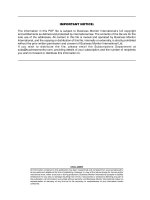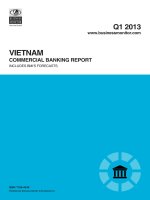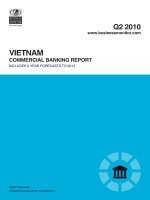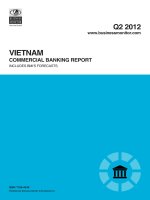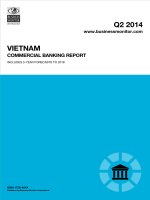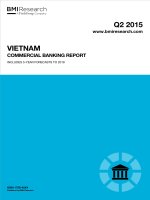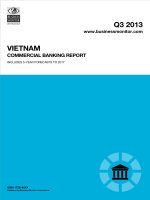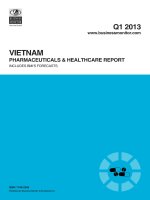Vietnam freight transport report q2 2013
Bạn đang xem bản rút gọn của tài liệu. Xem và tải ngay bản đầy đủ của tài liệu tại đây (529.35 KB, 75 trang )
Q2 2013
www.businessmonitor.com
VIETNAM
FREIGHT TRANSPORT REPORT
INCLUDES 5-YEAR FORECASTS TO 2017
ISSN 1750-5364
Published by:Business Monitor International
Vietnam Freight Transport Report
Q2 2013
INCLUDES 5-YEAR FORECASTS TO 2017
Part of BMI’s Industry Report & Forecasts Series
Published by: Business Monitor International
Copy deadline: February 2013
Business Monitor International
Senator House
85 Queen Victoria Street
London
EC4V 4AB
United Kingdom
Tel: +44 (0) 20 7248 0468
Fax: +44 (0) 20 7248 0467
Email:
Web:
© 2013 Business Monitor International
All rights reserved.
All information contained in this publication is
copyrighted in the name of Business Monitor
International, and as such no part of this
publication may be reproduced, repackaged,
redistributed, resold in whole or in any part, or used
in any form or by any means graphic, electronic or
mechanical, including photocopying, recording,
taping, or by information storage or retrieval, or by
any other means, without the express written consent
of the publisher.
DISCLAIMER
All information contained in this publication has been researched and compiled from sources believed to be accurate and reliable at the time of
publishing. However, in view of the natural scope for human and/or mechanical error, either at source or during production, Business Monitor
International accepts no liability whatsoever for any loss or damage resulting from errors, inaccuracies or omissions affecting any part of the
publication. All information is provided without warranty, and Business Monitor International makes no representation of warranty of any kind as
to the accuracy or completeness of any information hereto contained.
Vietnam Freight Transport Report Q2 2013
CONTENTS
BMI Industry View ............................................................................................................... 7
SWOT .................................................................................................................................. 10
Freight Transport .................................................................................................................................... 10
Business Environment .............................................................................................................................. 12
Economic ............................................................................................................................................... 13
Political ................................................................................................................................................. 14
Industry Forecast .............................................................................................................. 15
Road Freight ......................................................................................................................................... 18
Table: Road Freight, 2010-2017 . . . . . . . . . . . . . . . . . . . . . . . . . . . . . . . . . . . . . . . . . . . . . . . . . . . . . . . . . . . . . . . . . . . . . . . . . . . . . . . . . . . . . . . . . . . . . . . . . . . . . . . . . . . . . . . . . . . . . . . . 20
Inland Waterways .................................................................................................................................. 20
Table: Inland Waterway Freight, 2010-2017 . . . . . . . . . . . . . . . . . . . . . . . . . . . . . . . . . . . . . . . . . . . . . . . . . . . . . . . . . . . . . . . . . . . . . . . . . . . . . . . . . . . . . . . . . . . . . . . . . . . . . . . . . . . 22
Rail Freight .......................................................................................................................................... 22
Table: Vietnam Transport Network Length (km) . . . . . . . . . . . . . . . . . . . . . . . . . . . . . . . . . . . . . . . . . . . . . . . . . . . . . . . . . . . . . . . . . . . . . . . . . . . . . . . . . . . . . . . . . . . . . . . . . . . . . . . 22
Table: Rail Freight, 2010-2017 . . . . . . . . . . . . . . . . . . . . . . . . . . . . . . . . . . . . . . . . . . . . . . . . . . . . . . . . . . . . . . . . . . . . . . . . . . . . . . . . . . . . . . . . . . . . . . . . . . . . . . . . . . . . . . . . . . . . . . . . . 23
Air Freight ............................................................................................................................................ 23
Table: Air Freight, 2010-2017 . . . . . . . . . . . . . . . . . . . . . . . . . . . . . . . . . . . . . . . . . . . . . . . . . . . . . . . . . . . . . . . . . . . . . . . . . . . . . . . . . . . . . . . . . . . . . . . . . . . . . . . . . . . . . . . . . . . . . . . . . . 25
Maritime Freight ................................................................................................................................... 25
Table: Maritime Freight, 2010-2017 . . . . . . . . . . . . . . . . . . . . . . . . . . . . . . . . . . . . . . . . . . . . . . . . . . . . . . . . . . . . . . . . . . . . . . . . . . . . . . . . . . . . . . . . . . . . . . . . . . . . . . . . . . . . . . . . . . . 27
Trade ................................................................................................................................................... 27
Table: Trade Overview, 2010-2017 . . . . . . . . . . . . . . . . . . . . . . . . . . . . . . . . . . . . . . . . . . . . . . . . . . . . . . . . . . . . . . . . . . . . . . . . . . . . . . . . . . . . . . . . . . . . . . . . . . . . . . . . . . . . . . . . . . . . . 27
Table: Key Trade Indicators, 2010-2017 . . . . . . . . . . . . . . . . . . . . . . . . . . . . . . . . . . . . . . . . . . . . . . . . . . . . . . . . . . . . . . . . . . . . . . . . . . . . . . . . . . . . . . . . . . . . . . . . . . . . . . . . . . . . . . . 28
Table: Main Import Partners (US$mn) . . . . . . . . . . . . . . . . . . . . . . . . . . . . . . . . . . . . . . . . . . . . . . . . . . . . . . . . . . . . . . . . . . . . . . . . . . . . . . . . . . . . . . . . . . . . . . . . . . . . . . . . . . . . . . . . . 29
Table: Main Export Partners (US$mn) . . . . . . . . . . . . . . . . . . . . . . . . . . . . . . . . . . . . . . . . . . . . . . . . . . . . . . . . . . . . . . . . . . . . . . . . . . . . . . . . . . . . . . . . . . . . . . . . . . . . . . . . . . . . . . . . . 29
Market Overview ............................................................................................................... 30
Industry Trends And Developments ................................................................................ 35
Maritime ..............................................................................................................................................
Multimodal ...........................................................................................................................................
Road ....................................................................................................................................................
Air ......................................................................................................................................................
35
36
37
38
Company Profile ................................................................................................................ 39
Vietnam Airlines Cargo ............................................................................................................................ 39
Vietnam Petroleum Transport Company (VIPCO) .......................................................................................... 41
Vietnam National Shipping Lines (Vinalines) ................................................................................................ 43
Regional Overview ............................................................................................................ 46
Political Outlook ..................................................................................................................................... 46
Domestic Politics ................................................................................................................................... 46
© Business Monitor International
Page 4
Vietnam Freight Transport Report Q2 2013
Table: Vietnam Political Overview System of Government . . . . . . . . . . . . . . . . . . . . . . . . . . . . . . . . . . . . . . . . . . . . . . . . . . . . . . . . . . . . . . . . . . . . . . . . . . . . . . . . . . . . . . . . . . . . 47
Long-Term Political Outlook .................................................................................................................... 48
Global Industry Overview .................................................................................................. 52
Global Oil Products Price Outlook ............................................................................................................. 52
Table: BMI's Oil Price Forecasts, Average Price (US$/bbl) . . . . . . . . . . . . . . . . . . . . . . . . . . . . . . . . . . . . . . . . . . . . . . . . . . . . . . . . . . . . . . . . . . . . . . . . . . . . . . . . . . . . . . . . . . . 52
Table: BMI's Refined Products Forecasts . . . . . . . . . . . . . . . . . . . . . . . . . . . . . . . . . . . . . . . . . . . . . . . . . . . . . . . . . . . . . . . . . . . . . . . . . . . . . . . . . . . . . . . . . . . . . . . . . . . . . . . . . . . . . . 53
Refiners: Is The Party Over? .................................................................................................................... 55
Jet Fuel: Middle East & Africa Remain Positive As Global Air Traffic Slumps ................................................... 58
Table: Total Air Freight & Passenger Volumes . . . . . . . . . . . . . . . . . . . . . . . . . . . . . . . . . . . . . . . . . . . . . . . . . . . . . . . . . . . . . . . . . . . . . . . . . . . . . . . . . . . . . . . . . . . . . . . . . . . . . . . . 60
Gasoline And Diesel: Demand Destruction Takes A Toll ................................................................................ 60
Naphtha: Asia Stays Afloat While Europe Sinks ........................................................................................... 61
Bunker Fuels: Trans-Pacific Route Rebound Amid High Prices ....................................................................... 61
Macroeconomic Forecasts ............................................................................................... 64
Ratings Downgrade Failed To Surprise Investors .........................................................................................
Early Signs Of A Recovery .......................................................................................................................
Threat Of Slower Growth Yet To Undermine Efforts For Reforms ....................................................................
Expenditure Breakdown ..........................................................................................................................
65
67
67
67
Table: Vietnam - Economic Activity . . . . . . . . . . . . . . . . . . . . . . . . . . . . . . . . . . . . . . . . . . . . . . . . . . . . . . . . . . . . . . . . . . . . . . . . . . . . . . . . . . . . . . . . . . . . . . . . . . . . . . . . . . . . . . . . . . . . 68
Demographic Forecast ..................................................................................................... 69
Table: Vietnam's Population By Age Group, 1990-2020 ('000) . . . . . . . . . . . . . . . . . . . . . . . . . . . . . . . . . . . . . . . . . . . . . . . . . . . . . . . . . . . . . . . . . . . . . . . . . . . . . . . . . . . . . . . . 70
Table: Vietnam's Population By Age Group, 1990-2020 (% of total) . . . . . . . . . . . . . . . . . . . . . . . . . . . . . . . . . . . . . . . . . . . . . . . . . . . . . . . . . . . . . . . . . . . . . . . . . . . . . . . . . . 71
Table: Vietnam's Key Population Ratios, 1990-2020 . . . . . . . . . . . . . . . . . . . . . . . . . . . . . . . . . . . . . . . . . . . . . . . . . . . . . . . . . . . . . . . . . . . . . . . . . . . . . . . . . . . . . . . . . . . . . . . . . . 72
Table: Vietnam's Rural And Urban Population, 1990-2020 . . . . . . . . . . . . . . . . . . . . . . . . . . . . . . . . . . . . . . . . . . . . . . . . . . . . . . . . . . . . . . . . . . . . . . . . . . . . . . . . . . . . . . . . . . . 72
Methodology ...................................................................................................................... 73
How We Generate Our Industry Forecasts ................................................................................................... 73
Transport Industry ................................................................................................................................. 74
Sources ................................................................................................................................................ 74
© Business Monitor International
Page 5
Vietnam Freight Transport Report Q2 2013
BMI Industry View
A projected lacklustre recovery in global demand in 2013 leads us to envisage a less than impressive pickup
in Vietnamese exports, which will have a knock-on effect on the country's freight industry. Additionally,
Vietnam's main export partners, the US, China and Japan, are all finding it hard to shake off the economic
hangover of 2012. Vietnam's economy, however, remains on track for a robust recovery in 2013, and we
view consensus estimates on growth as being overly pessimistic. Also, looking at the breakdown of exports,
we are seeing encouraging evidence that Vietnam is becoming less reliant on refined crude imports and
could soon become a net exporter of crude oil over the coming years.
Garment producers in Vietnam are preparing for the Trans-Pacific Partnership agreement (TPP) that would
increase the country's garment exports to the US to up to US$22bn by 2020. Vietnam presently exports US
$7.6bn worth of garments to the US, and is likely to see this rise to US$13bn worth of garments by 2020.
However, the country relies heavily on China, Taiwan and South Korea for raw material and in 2012 had
imported US$10.77bn worth of materials by November 15. Le Quoc An, a senior advisor to the Vietnam
Textile and Apparel Association, has said that the country would have to reduce this import dependence in
order to export an additional US$9bn worth of products to the US by 2020. The TPP is expected to create
millions of job opportunities in the area of garment production.
We acknowledge that the risk of a potential surge in commodity prices in 2013 - especially food prices,
which make up around 40% of the CPI basket - could turn out to be a wildcard for policymakers. But for
now, we believe that overall conditions in Vietnam support our forecast for real GDP growth to come in
relatively strong at 7.0% in 2013.
By mode, the outperformer in year-on-year (y-o-y) tonnage terms is set to be the road freight sector, with
2013's growth figure forecast to come in at just over 7%. The air freight sector will enjoy healthy growth of
just under 5% this year, while rail freight's annual tonnage growth will be a less impressive 3.1%. In
Vietnam's shipping sector, the Port of Ho Chi Minh City remains by far the country's largest port and will
also be Vietnam's strongest performer in terms of tonnage handled this year - forecast to increase 7.56%
year-on-year (y-o-y) in 2013 to reach 38.75mn tonnes, compared with the Port of Da Nang's predicted
annual growth of 4.33% (to 4.16mn tonnes). On the other hand, the Port of Da Nang will enjoy the higher
levels of annual growth in terms of containers handled, with y-o-y growth set to come in at double figures in
2013, as opposed to the Port of Ho Chi Minh City's lower growth of 8.03%.
© Business Monitor International
Page 7
Vietnam Freight Transport Report Q2 2013
Headline Industry Data
■
2013 rail freight tonnage is set to increase by 3.12% to 8.71mn tonnes.
■
2013 air freight tonnage is forecast to rise by 4.8% to 216,280 tonnes.
■
Tonnage handled at the Port of Ho Chi Minh City in 2013 is forecast to grow 7.56%, whereas tonnage
handled at the Port of Da Nang is forecast to increase 4.33%.
■
2013 road freight tonnage is forecast to grow by 7.03% to 754.16mn tonnes.
■
2013 total trade is forecast to rise by 5.70%.
Key Industry Trends
Government Must Delay Launch Of Cai Mep-Thi Vai Port Complex The launch of the Cai Mep-Thi Vai
port complex in the south of the country has been delayed by the government of Vietnam. A delay had been
proposed by Vietnam Business Forum 2012's Infrastructure Working Group and representatives from some
foreign-invested businesses providing port services, it was reported in December 2012.
CEVA Logistics And Indo Trans Logistics Group Form JV
CEVA Logistics of the UK and Vietnam's Indo Trans Logistics Group have announced a joint venture
(JV), to be called CEVA Logistics (Vietnam), in a move designed to strengthen CEVA Logistics' position
in South East Asia. CEVA Logistics (Vietnam) will provide end-to-end integrated supply chain services and
will be based in Ho Chi Minh City. CEVA Logistics had at first offered only freight management services
when it began operations in the country 12 years ago.
Roads Construction Potential Limited By Viability Concerns
Vietnam's desire to improve its road infrastructure continues to be hampered by numerous issues, such as
declining government spending, the lack of economic viability for toll roads and a deficiency in regulations
and government institutions that causes delays in site clearances and cost overruns. We believe these
problems are not likely to be resolved anytime soon and we maintain a conservative outlook on construction
activity in Vietnam's road infrastructure sector.
© Business Monitor International
Page 8
Vietnam Freight Transport Report Q2 2013
Key Risks To Outlook
The Thai and Vietnamese transport ministries recommended at the end of 2012 that their respective
governments extend the Khon Khen-Tien Sa Port road from Laem Chabang Port in Thailand to Hanoi and
Haiphong in Vietnam, reported the Saigon Times. The aim is to improve the efficiency of the road.If
completed, this will provide upside risk to the Vietnamese freight industry going forward.
With the US by far and away Vietnam's largest export partner, the Asian country's fortunes are very much
intertwined with those of the global superpower. It will come as a negative then that we are maintaining our
2.0% real GDP growth forecast for the US for 2012 and our 2.1% projection for 2013. The US economy is
running dangerously close to 'stall speed', by which we mean that any major unanticipated headwind would
be enough to push it into recession. The knock-on effect on Vietnam's freight industry would therefore be
detrimental, as demand would slow significantly.
© Business Monitor International
Page 9
Vietnam Freight Transport Report Q2 2013
SWOT
Freight Transport
Vietnam Freight Transport Industry SWOT
Strengths
■
Vietnam's strong domestic growth rate, coupled with its geography - it stretches for
thousands of kilometres on a north-south axis, creates a need for long-distance
freight haulage.
■
A recovery of activity levels at the nation's ports in 2010 is expected to continue over
the mid-term to 2016.
■
Vietnam's location on the South China Sea gives the country access to the main interAsian shipping routes, as well as access to the developing land transport links with
ASEAN countries, allowing the country scope to develop its trade logistics.
Weaknesses
■
The generally poor state of the road network. Despite new highway construction, only
13.5% of the network is considered to be in good condition. Just 26% of the network
has two or more lanes and only 29% is tarred.
■
Traditionally low investment in rail, with the potential for cost-effective bulk rail freight
being underutilised.
■
Decades of under-investment have left the country with a port infrastructure system
that is poor by international standards. Overcapacity is a growing problem.
■
Unresolved business environment issues and lack of significant improvement in
access to infrastructure financing means that we remain very conservative on the
growth potential of Vietnam's freight sector.
■
A slowdown affecting the US economy has a knock-on effect on Vietnam due to it
being the Asian country's largest export partner.
Opportunities
■
The beginnings of local commercial vehicle production, which will help improve the
stock of lorries used by road haulage companies.
■
Chinese investment could bring about much needed improvements in the rail sector.
© Business Monitor International
Page 10
Vietnam Freight Transport Report Q2 2013
Vietnam Freight Transport Industry SWOT - Continued
• Growing international interest in Vietnam as a growth market within the box shipping
sector.
Threats
■
Vietnam risks losing out to neighbouring countries if it is unable to develop its
infrastructure to keep up with the pace of demand.
■
Vietnam is vulnerable to any slowdown in Chinese investment and to political risk in
the sensitive South China Sea, subject to competing sovereignty claims.
• A drop in international demand for exports would negatively affect Vietnam's freight
transport sector.
© Business Monitor International
Page 11
Vietnam Freight Transport Report Q2 2013
Business Environment
SWOT Analysis
Strengths
■
Vietnam has a large, skilled and low-cost workforce, which has made the country
attractive to foreign investors.
■
Vietnam's location - its proximity to China and South East Asia, and its good sea links
- makes it a good base for foreign companies to export to the rest of Asia and
beyond.
Weaknesses
■
Vietnam's infrastructure is still weak. Roads, railways and ports are inadequate to
cope with the country's economic growth and links with the outside world.
■
Vietnam remains one of the world's most corrupt countries. According to
Transparency International's 2012 Corruption Perceptions Index, Vietnam ranks 123rd
out of 176 countries.
Opportunities
■
Vietnam is increasingly attracting investment from key Asian economies, such as
Japan, South Korea and Taiwan. This offers the possibility of the transfer of high-tech
skills and know-how.
■
Vietnam is pressing ahead with the privatisation of state-owned enterprises and the
liberalisation of the banking sector. This is likely to offer foreign investors new entry
points.
Threats
■
Ongoing trade disputes with the US, and the general threat of American
protectionism, which will remain a concern.
■
Labour unrest remains a lingering threat. A failure by the authorities to boost skills
levels could leave Vietnam a second-rate economy for an indefinite period.
© Business Monitor International
Page 12
Vietnam Freight Transport Report Q2 2013
Economic
SWOT Analysis
Strengths
■
Vietnam has been one of the fastest-growing economies in Asia in recent years, with
GDP growth averaging 7.1% annually between 2000 and 2011.
■
The economic boom has lifted many Vietnamese out of poverty, with the official
poverty rate in the country falling from 58% in 1993 to 14.0% in 2010.
Weaknesses
■
Vietnam still suffers from substantial trade, current account and fiscal deficits, leaving
the economy vulnerable to global economic uncertainties in 2012. The fiscal deficit is
dominated by substantial spending on social subsidies that could be difficult to
withdraw.
■
The heavily-managed and weak currency reduces incentives to improve quality of
exports, and also keeps import costs high, contributing to inflationary pressures.
Opportunities
■
WTO membership has given Vietnam access to both foreign markets and capital,
while making Vietnamese enterprises stronger through increased competition.
■
The government will in spite of the current macroeconomic woes, continue to move
forward with market reforms, including privatisation of state-owned enterprises, and
liberalising the banking sector.
■
Urbanisation will continue to be a long-term growth driver. The UN forecasts the
urban population rising from 29% of the population to more than 50% by the early
2040s.
Threats
■
Inflation and deficit concerns have caused some investors to re-assess their hitherto
upbeat view of Vietnam. If the government focuses too much on stimulating growth
and fails to root out inflationary pressure, it risks prolonging macroeconomic
instability, which could lead to a potential crisis.
■
Prolonged macroeconomic instability could prompt the authorities to put reforms on
hold as they struggle to stabilise the economy.
© Business Monitor International
Page 13
Vietnam Freight Transport Report Q2 2013
Political
SWOT Analysis
Strengths
■
The Communist Party of Vietnam remains committed to market-oriented reforms and
we do not expect major shifts in policy direction over the next five years. The oneparty system is generally conducive to short-term political stability.
■
Relations with the US have witnessed a marked improvement, and Washington sees
Hanoi as a potential geopolitical ally in South East Asia.
Weaknesses
■
Corruption among government officials poses a major threat to the legitimacy of the
ruling Communist Party.
■
There is increasing (albeit still limited) public dissatisfaction with the leadership's tight
control over political dissent.
Opportunities
■
The government recognises the threat corruption poses to its legitimacy, and has
acted to clamp down on graft among party officials.
■
Vietnam has allowed legislators to become more vocal in criticising government
policies. This is opening up opportunities for more checks and balances within the
one-party system.
Threats
■
Macroeconomic instabilities in 2012 are likely to weigh on public acceptance of the
one-party system, and street demonstrations to protest economic conditions could
develop into a full-on challenge of undemocractic rule.
■
Although strong domestic control will ensure little change to Vietnam's political scene
in the next few years, over the longer term, the one-party-state will probably be
unsustainable.
■
Relations with China have deteriorated over recent years due to Beijing's more
assertive stance over disputed islands in the South China Sea and domestic criticism
of a large Chinese investment into a bauxite mining project in the central highlands,
which could potentially cause wide-scale environmental damage.
© Business Monitor International
Page 14
Vietnam Freight Transport Report Q2 2013
Industry Forecast
Vietnam's freight transport sector will benefit from the uptick in domestic growth and also the growth
outlook of its two main trade partners, the USA and China, which will drive export growth. Vietnam's
logistics sector has been developing to keep up with the country's increasing role as Asia's factory,
especially in the manufacturing of clothing and shoes. Vietnam's connections to its key export partners has
been improving over the last three years, with the country now boasting direct container line services to the
US and Europe.
Vietnam's economic growth is picking up. While the country's economy continued to expand at a reasonable
rate of 5% on 2012 this year marked the second year in which Vietnam's real GDP slowed. In 2013 BMI
forecasts the country's economic expansion to get back on its growth trajectory with Vietnam's real GDP
projected to grow by 6.95%.
Economic Growth Getting Back On Course
Vietnam Real GDP Growth, % change y-o-y
e/f = BMI estimate/ forecast. Source: Asian Development Bank, General Statistics Office
© Business Monitor International
Page 15
Vietnam Freight Transport Report Q2 2013
The country's medium-term growth will place even more pressure on the country's logistics sector with
Vietnam's economy forecast to expand quicker over the next four years, with an average growth of 7%
predicted between 2013-2017 compared to an average annual growth of 5.9% between 2008-2012.
To keep pace with this growth Vietnam will continue to need to invest in its logistics sector, but BMI
expects a lot of this investment to come from outside logistic and freight transport companies which will be
keen to enter and expand into this high growth market. We have already witnessed this to some extent in
Vietnam's port sector, with considerable investment being made by container shipping lines and global port
operators in the development of modern box terminals at Vietnam's ports.
This investment in the country's maritime sector has ensured that Vietnam's manufacturing growth can be
achieved with greater links between the country and its main trade partner the US. Direct container shipping
links between Vietnam and the US have been in operation since 2009, which have cut both time and cost, as
previously Vietnamese shipments had to be transshipped via Singapore.
Demand from the US for Vietnam's manufactured goods looks set to continue growing, with Vietnam's
exports set to benefit from the recovery in the US economy. We have revised up our US real GDP forecast
for 2013 to 2.3% an improvement on the estimated increase of 2.2% in 2012. Over the medium term
(2013-2017) we forecast the US economy to expand by an average 2.4% per annum.
© Business Monitor International
Page 16
Vietnam Freight Transport Report Q2 2013
Title: China And The US To Drive Export Growth
LHC: Vietnam's Main Trade Partners By % 2011. RHC: China and US Real GDP growth, % change yo-y
e/f = BMI estimate/ forecast. Source: CIA World Factbook, National Bureau of Statistics and BEA
Vietnam's export outlook will also continue to be bolstered by China's growth outlook. Although we project
China's economic growth to slow over the medium term, the country's real GDP growth outlook remains
robust, estimated at 7.5% in 2013 and 6.4% over the medium term.
Vietnam plays a key role in China's coal supply chain. Vietnam is China's fifth-largest coal supplier
providing the country with the thermal coal it requires for its power stations. Vietnam's role in this supply
chain looks set to continue, although BMI highlights that China is trying to decrease its power sectors'
reliance on coal. While we believe that the percentage supplied by coal fired power plants within China's
overall energy mix will slip over the medium term, it will nevertheless remain above 70%.
© Business Monitor International
Page 17
Vietnam Freight Transport Report Q2 2013
Playing A Major Role In China's Coal Supply Chain
China Coal Imports By Partner 2012 (tonnes)
Source: China Custom
BMI believes that Vietnam's textile sector will also benefit from the development of China's middle class,
as the country starts to import more from abroad.
Road Freight
Road Dominates And Offers Best Links Into China
Despite its low standing in road infrastructure, with the Global Economic Forum ranking Vietnam's roads at
123 out of 142 globally, and placing it last in comparison with 13 of its Asia peers, the country's logistics
needs are primarily met by road.
In 2013 we predict that road freight volumes in Vietnam will account for 80.7% freight carried in the
country.
© Business Monitor International
Page 18
Vietnam Freight Transport Report Q2 2013
Road Reliant
Vietnam Freight Mode Breakdown By Market Share 2013
Source: BMI forecast
We forecast that growth in road freight volume will strengthen in 2013 in line with the pickup in Vietnam's
economic recovery and the stronger export outlook for the country. We project road freight volumes to
increase by 7%, up from an estimated 6.1% in 2012, to reach 754.2mn tonnes in 2013.
This growth in road freight volumes, while robust, is down on the double-digit growth figures that this
freight mode achieved in the previous five years. Over the medium term we forecast road freight volume
growth will average 6.6% per annum reaching a projected 970.1mn tonnes in 2017.
There is, however, upside risk to this forecast as more foreign logistics companies, with considerable road
freight expertise expand in Vietnam. Recently both FedEx and DHL have been expanding their role in
Vietnam. While some companies are breaking into Vietnam by developing their own operations in the
country, others are getting a head start by acquiring and joining up with domestic freight operators. This is
the route CEVA Logistics has taken entering into a joint venture with its long-term business partner Indo
Trans Logistics Group.
© Business Monitor International
Page 19
Vietnam Freight Transport Report Q2 2013
Road freight plays a key role not only in Vietnam's domestic logistics sector, but also in the country's export
supply chain. Road is the main form of transport linking Vietnam's factories to the country's ports and also
plays a key role in linking Vietnam with its second-largest export partner China.
Vietnam's northern border links the country's with the south of China. Road links continue to be developed
between the two and with them trucking services. Kerry Asia Road Transport (Kart), for example, offers
a twice-weekly trucking link connecting Shenzhen and Hanoi.
Table: Road Freight, 2010-2017
2010
Road freight, '000
tonnes
2012e
2013f
2014f
2015f
2016f
2017f
587,014.20 663,913.10 704,610.97 754,159.26 805,226.64 858,429.28 913,443.34 970,287.72
- % change y-o-y
Road freight, mn
tonnes/km
2011
14.29
13.1
6.13
7.03
6.77
6.61
6.41
6.22
36,179.00
40,231.00
42,383.36
45,369.02
48,446.33
51,689.07
55,084.19
58,592.19
14.54
11.2
5.35
7.04
6.78
6.69
6.57
6.37
- % change y-o-y
e/f = BMI estimate/forecast. Source: General Statistics Office of Vietnam
Inland Waterways
Waterways Play A Major Role; Mekong Offers Trade Links With Neighbours
Vietnam's inland waterways play a considerable role in the country's freight transport sector making it the
second-largest freight transport mode in the country. In 2013 we estimate that 172.7mn tonnes of freight
will be carried by the nation's waterways, a year-on-year (y-o-y) growth of 5.3%. In terms of total freight
transport projections for Vietnam in 2013 we calculate that inland waterways will account for 18.5%.
© Business Monitor International
Page 20
Vietnam Freight Transport Report Q2 2013
Mekong Offers Trade Connections
Map of the Mekong River
Source: BMI
The country's inland waterways stretch for 17,702km, of which 5,000km is navigable for vessels with a
draught of up to 1.8m. Vietnam's dense network of waterways ranks its seventh in the world in terms of
length.
The country's inland waterways include the Mekong River, which enables freight connections with
Vietnam's neighbours.
© Business Monitor International
Page 21
Vietnam Freight Transport Report Q2 2013
Table: Inland Waterway Freight, 2010-2017
2010
2011
2012e
2013f
2014f
2015f
2016f
2017f
Inland waterway
freight, '000 tonnes 144,227.00 157,207.40 163,951.60 172,671.63 181,659.35 191,130.25 201,046.17 211,291.77
- % change y-o-y
Inland waterway
freight, mn tonnes/
km
- % change y-o-y
4.73
9
4.29
5.32
5.21
5.21
5.19
5.1
31,679.00
36,620.90
38,232.22
40,247.42
42,324.49
44,513.21
46,804.78
49,172.55
1.37
15.6
4.4
5.27
5.16
5.17
5.15
5.06
e/f = BMI estimate/forecast. Source: General Statistics Office of Vietnam
Rail Freight
Network Lacking And No Impetus To Develop It
Despite rail's potential as an overland trade link for Vietnam with its three neighbours the mode's role in the
country's freight transport sector remains small. In 2013 we forecast Vietnam's rail freight volumes to
account for just 0.8% of the total with the country's rail network transporting just 7.5mn tonnes of freight.
Although like the other freight modes, we expect volumes to increase in line with Vietnam's economic
growth outlook, rail freight volumes (while forecast to grow by 16.9% over the next five years) will only be
handling 8.6mn tonnes in 2017; this is still way below that which we forecast for the nation's other main
freight modes, road and inland waterways.
There are two key factors that we believe have held back Vietnam's rail freight development and will
continue to do so.
Table: Vietnam Transport Network Length (km)
Vietnam Transport Network
Road
Railway
Inland Waterway
Length (km)
180,549 km
17,702 km
2,632 km
CIA World Factbook
© Business Monitor International
Page 22
Vietnam Freight Transport Report Q2 2013
The first is the quality of Vietnam's railway infrastructure. The Global Economic Formula gives Vietnam's
rail infrastructure a low ranking, placing it 71st globally out of 123 countries measured. This ranking places
it 12th out of its 13 Asian peers. A major problem for Vietnam's rail freight development is the relative
shortness of the country's rail network. Vietnam's railway lines extend for just 2,632km; this compares with
the country's 180,549km network of roads and 17,702km network of inland waterways.
The second drawback for freight rail development in Vietnam is its gauge incompatibility with China.
Vietnam's network is dominated by narrow gauge, which accounts for 80% of the total. While the country
has some standard gauge track, this system only accounts for 20% of the total.
This means that rail freight trade between Vietnam and China is slowed by gauge changes, making road
freight a more cost- and time-effective alternative; this stymies potential rail-freight projects between the
two nations.
BMI highlights that developments in Vietnam's rail network are taking place, but these have been focused
on expanding the country's passenger network (e.g. a planned high-speed railway link between Vietnam and
Laos).
Table: Rail Freight, 2010-2017
Rail freight, '000 tonnes
- % change y-o-y
Rail freight, mn tonnes/km
- % change y-o-y
2010
2011
2012e
2013f
2014f
2015f
2016f
2017f
7,861.50
7,234.10
7,315.85
7,544.24
7,779.64
8,027.69
8,287.41
8,555.75
-4.68
-7.98
1.13
3.12
3.12
3.19
3.24
3.24
3,960.90
4,098.50
4,199.73
4,401.32
4,651.09
4,914.28
5,189.85
5,474.57
2.49
3.47
2.47
4.8
5.67
5.66
5.61
5.49
e/f = BMI estimate/forecast. Source: General Statistics Office of Vietnam
Air Freight
Airfreight On Growth Trajectory As Vietnam Gets Better Connected
Vietnam's air freight sector may only account for a small percentage of the country's freight transport sector;
although this is not expected to change there is a lot of growth potential in this sector. As intra-Asia air
freight routes develop, Vietnam is becoming better connected with air freight routes internationally. The
key sectors that are demanding air freight as a transport option, include consumer electronics and
pharmaceuticals.
© Business Monitor International
Page 23
Vietnam Freight Transport Report Q2 2013
In line with Vietnam's economic growth and the projected pick up in international air freight BMI forecasts
the country's air freight volume growth to strengthen in 2013. We forecast Vietnam's air freight volumes to
increase by 4.8% to reach 216,280 tonnes in 2013 up from the estimated y-o-y growth of 3.6% in 2012.
Over the medium term (2013-2017) we forecast Vietnam's air freight levels to grow on average per annum
by 5.6% and by 31.3% over the full period to reach 270,990 tonnes.
There are upside risks to these forecasts stemming from the continued interest of international air freight
operators in Vietnam. Throughout 2012 Vietnam's Ho Chi Minh City airport became better connected with
more air freight routes and BMI expects this trend to continue in 2013 and beyond.
Taking Off
Vietnam Air Freight, '000 tonnes
e/f = BMI estimate/ forecast. Source: General Statistics Office of Vietnam
BMI expects the increase of air freight connections for Vietnam will come through the development of
intra-Asia air freight routes. In 2012 Air China Cargo and Malaysia's MASKargo added services to Ho Chi
Minh City.
Vietnam is also becoming globally better connected by air. In 2012 Emirates added a link with the country
and Dubai and in 2013 Finnair announced that it planned to launch new cargo routes to Hanoi.
© Business Monitor International
Page 24
Vietnam Freight Transport Report Q2 2013
While still at the development stage Vietnam is seeking to play a greater role in the electronics supply
chain, a key source of demand for air freight transport options. One examples has been the impact the local
production of iPhones has had on China's air freight sector. Plans are in place for Vietnam-based facilities to
produce Nokia phones, iPods, PlayStations and Sony laptops, which will all drive up air freight demand.
Vietnam's pharmaceutical sector exports much of its output, but the country also imports a lot. Vietnam's
trade in pharmaceuticals is forecast to grow in the double digits in percentage terms over the medium term.
The global pharmaceutical sector is increasingly turning to the aviation sector to meet its freight needs, with
the sector offering savings in transport time, along withy environment controlled options, which are vital for
the transport of some medicines and vaccinations.
Table: Air Freight, 2010-2017
2010
2011
2012e
2013f
2014f
2015f
2016f
2017f
Air freight, '000 tonnes
190.1
199.2
206.37
216.28
229.01
242.43
256.48
270.99
- % change y-o-y
36.17
4.79
3.6
4.8
5.89
5.86
5.79
5.66
Air freight, mn tonnes/km
426.8
449
466.96
494.29
522.46
552.15
583.23
615.34
- % change y-o-y
34.81
5.2
4
5.85
5.7
5.68
5.63
5.51
e/f = BMI estimate/forecast. Source: General Statistics Office of Vietnam
Maritime Freight
Maritime Box Role To Continue Expanding
Vietnam's ports and shipping sectors play a role in the global dry, liquid and container sector. As
highlighted earlier Vietnam plays a considerable role in China's coal supply chain, with the dry bulk
commodity being shipped out of Vietnam and into China's main coal port of Qinhuangdao. Vietnam is an
oil-producing nation, but its consumption needs have come to outweigh its supply and so the country is
making use of the liquid bulk shipping sector to import oil.
It is in the container shipping sector that Vietnam has seen the most development, a trend which is expected
to continue. As Vietnam has become the factory of Asia, with an emphasis on the development of clothing
and shoe exports, the country's ports and shipping links have had to keep up. As mentioned, considerable
investment was ploughed into Vietnam's container terminal sector over the last five years, with international
players participating. This investment is now starting to yield results, with Vietnam now directly connected
to the key demand market of the US (in 2009) and Europe (in 2010).
© Business Monitor International
Page 25
